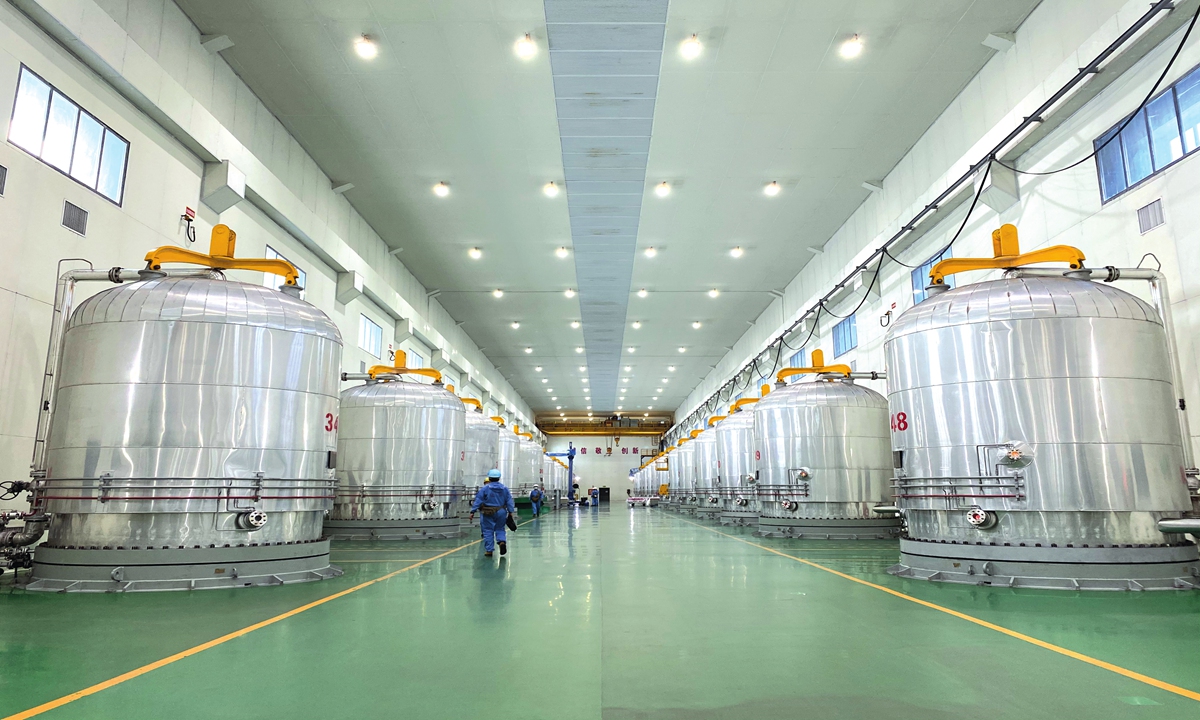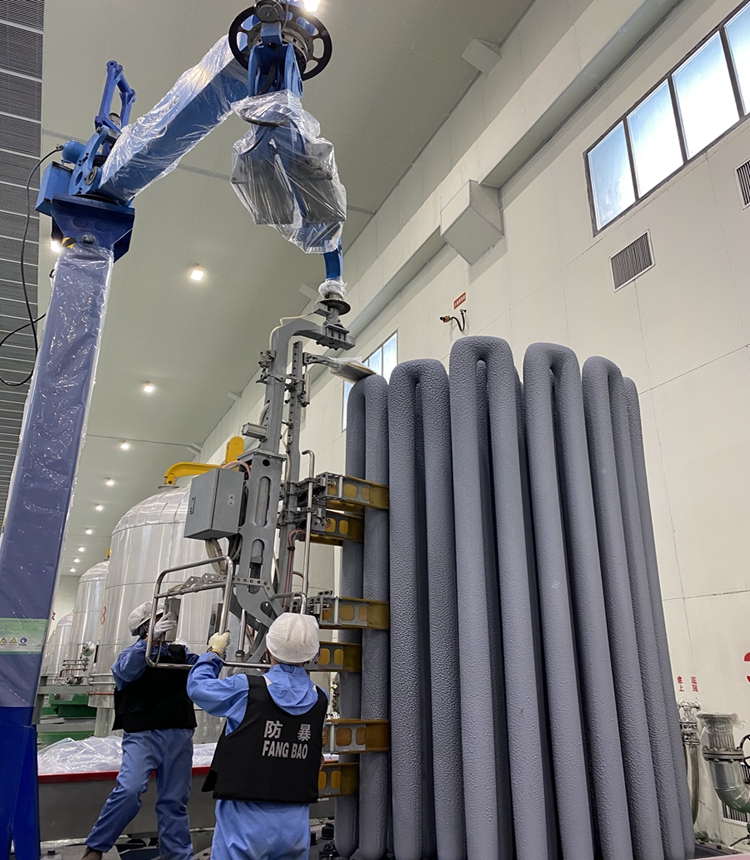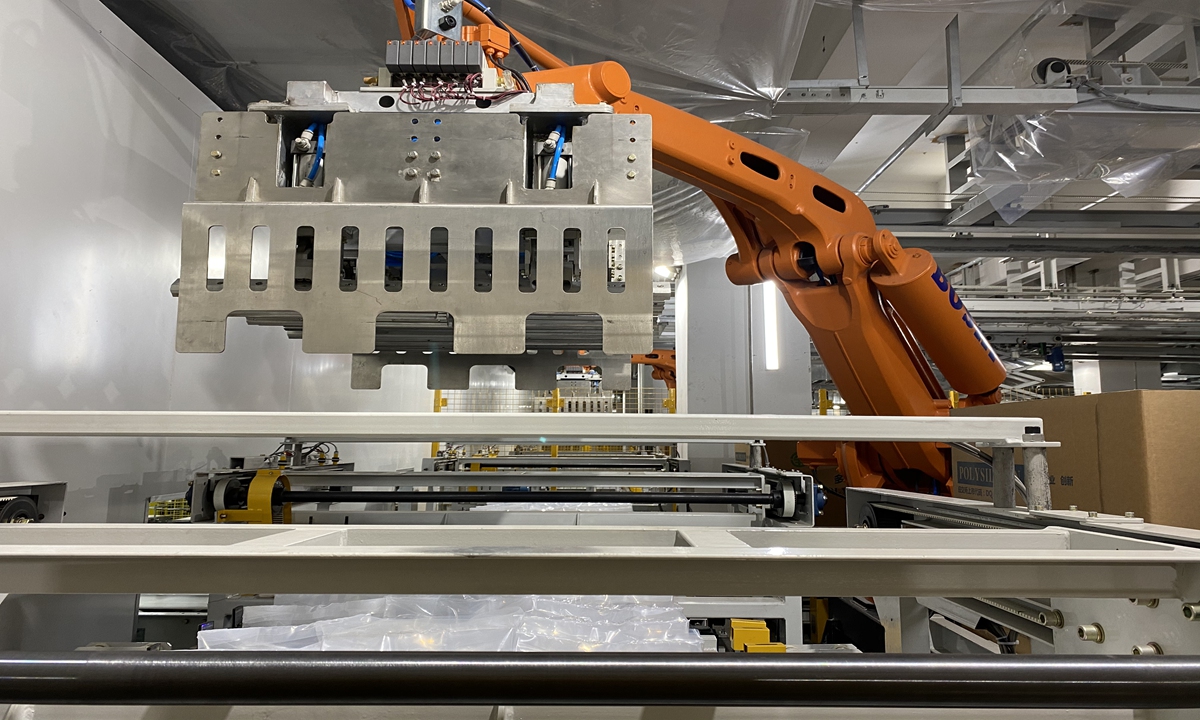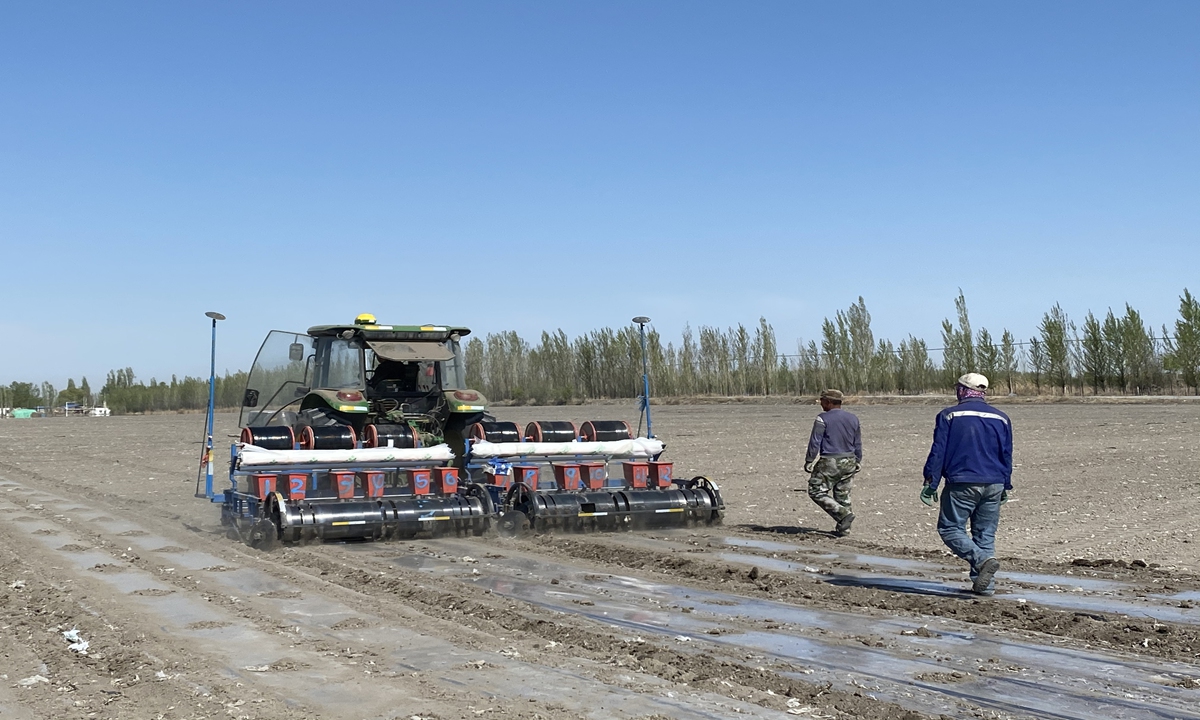At the factory gate of Xinjiang Daqo, a raw materials producer for global solar panels in Northwest China's Xinjiang Uygur Autonomous Region, a security guard dressed in a camouflage coat greets visitors. Walking into the facility, tall rectifying columns, continuous pipelines and numerous robot arms are ubiquitous, while workers in blue uniforms working with their hands are not common.
To any visitor, the first impression would be that this is a highly automated, efficient modern factory on par with world class facilities in Chinese manufacturing hubs and those in the US and Europe.
However, blinded by politics and bias, some Western politicians, business competitors and journalists, despite never set foot inside the factory, claimed that Daqo is one of the companies in Xinjiang that use "forced labor" to produce products that should be banned.
In their lies, the security guard dressed in camouflage coat is military personnel who keeps watch on the "forced workers", who dress in uniforms, which have been taken as proof of "forced labor" - never mind that uniforms are common in factories not just in China but across the world, and that camouflage coats are not just a common dress for ordinary people but have also become popular among some youngsters around the world.
Together with another three major polysilicon manufacturers in Xinjiang - GCL-Poly, East Hope Group and Xinte Energy--the four companies were named using "forced labor" by a Washington-based consultancy Horizon Advisory.
The four giants together produced around 243,000 tons of polysilicon in 2020, accounting for 36 percent of the global share and 55 percent of China's total polysilicon output, creating an output value of 15.05 billion yuan ($2.32 billion), people familiar with the matter told the Global Times.
The "forced labor" narrative continues to be pushed by some Western politicians, industry leaders and media outlets, including the New York Times and Bloomberg.
In the past week, Australian trade unions called for the federal government to invest in local solar components manufacturing following American unions' call to impose an import ban on solar products produced in Xinjiang.
Meanwhile, a Guardian report used confidential industry data claiming that up to 40 percent of the UK's solar farms had been built using the panels made by Chinese firms that were accused of exploiting "forced labor" in Xinjiang.
Outraged and furious with these groundless accusations, a manage at Xinjiang Daqo asked rhetorically: "If they must impose the phrase ['forced labor'] on us, does it mean we are forcing these machines to work?"
That question also captures the sentiment of businesses and workers in the local solar energy, cotton and tomato industries - all targets of the Western "forced labor" smear campaign; all are highly automated operation with high-paying jobs; and all are pillar industries supporting the livelihood of millions of residents in the region.
But apart from the vicious nature of such rumors aimed at suppressing rapidly growing industries in Xinjiang, it is almost laughable and utterly ridiculous how such lies do not have an ounce of truth and can easily be debunked. Indeed, one word should be enough: automation.
Recently, the Global Times' reporters visited a Xinjiang polysilicon manufacturing plant and cotton field, talked to workers, local cotton farmers and businesses, and witnessed first-hand the high level of automation in these sectors, which means little manual labor is needed in Xinjiang as labor costs surge in Chinese economy.

In the city of Shihezi, a two-hour drive or some 150 kilometers northwest of Urumqi, Xinjiang, a factory producing polysilicon unveiled its operations and detailed employee treatment to the Global Times reporters.
During a day-long visit at the 1.1 million square meter plant of Xinjiang Daqo, the Global Times reporters talked to workers, including those from ethnic minority groups, and were impressed by the plant's highly automated production and employee satisfaction.
The first employee the reporters ran into at the factory was a maintenance worker who got off from his night shift.
Dressed in a dark blue uniform, 36-year-old Qian Chongyu walked toward the gate of the facility at around 10 am. He could take two days off after the night shift.
The uniform, a cliché dressing code cited by multiple Western media outlets when they describe workers in Xinjiang, are the working uniforms given out free by the company - for workers' safety at a chemical plant.
Earning more than 6,500 yuan per month, Qian said he is satisfied with the salary as it is pretty good in the city of Shihezi. The average monthly salary at Xinjiang Daqo is 7,300 yuan, compared with the average monthly salary of 6,617 yuan in Xinjiang's non-private sector and 3,825 yuan for private sector in 2019.
In the central control room at the factory, a large electronic screen displays all operational data during the polysilicon manufacturing process, including the temperature of heating furnaces and abnormal indicator alarms. This information is recorded on a 5G-faciliated monitor digital platform.
The high level of digital automation enables workers to take patrol inspections in the factory without too much physical labor.

Take the chemical vapor deposition workshop as an example. The Global Times reporters only saw four workers when taking down the hot polysilicon rods from an electrified furnace in a temperature-controlled and dust-free workshop.
Holding a detecting instrument with a Honeywell logo on it in his hand, Mo Kezhang, head of a 133 team of the No.2 chemical vapor deposition workshop at Xinjiang Daqo, told the Global Times every step during the polysilicon manufacturing is monitored and traceable, and workers only need to check the operations every hour.
In the workshop, one furnace is able to accommodate 80 polysilicon rods, producing around 10 tons of polysilicon after 130 hours of heating, Mo said, adding the radius of a stick can expand from 15 millimeters to 150 millimeters after heating.
At Xinjiang Daqo, there are nearly 145 such furnaces, making the company's annual production capacity hit 77,288 tons in 2020, accounting for around 15 percent of global share.
Chemical vapor deposition is a small part in polysilicon manufacturing. There are two main steps in polysilicon manufacturing at Xinjiang Daqo - 24-hour nonstop production, requiring workers to take a day or night shift to monitor the operating parameters, and the section of smashing and packaging polysilicon chunks, Wang Xiyu, a deputy general manager at Xinjiang Daqo, told the Global Times.
"We are not a labor-intensive company, but a technology-intensive and capital-intensive one. After we used local equipment and machines, most of the operations and adjustments in the factory are conducted by computers and machines. A very small number of workers are needed to play a supporting role," Wang said.
Shattering the polysilicon rods used to require massive labor force, but now with the automated equipment and robot arms, the manpower needed during this step dropped by around 80 percent compared with the company's founding year in 2011, Yang Chengjie, secretary of the general manager at Xinjiang Daqo, told the Global Times.
After the chemical vapor deposition, polysilicon rods are smashed into chunks. Every 10 kilograms of the chunks are packaged into one bag and will be sold to silicon wafer producers.
All of these jobs are done without any manpower. The robot arms will capture the bags and put 60 bags into a huge box.
Every box will be put on a QR code. A Global Times reporter used her smartphone to scan the code, displaying "polycrystalline silicon, 600kg, groupid8" on the phone.
Robot arms will send the bags into designated storage racks in the warehouse via mechanical tracks before shipment, just like any modern logistics warehouse in Chinese e-commerce companies. Only one staff is monitoring the warehouse.
"It is clear that we need very a small number of workers. They mainly assist or inspect. So the 'forced labor' claim is nonsense. If they must impose the label on us, does it mean we are forcing these machines to work?" Yang said. "The US also forces their aircraft carriers to work too!"
According to Yang, most of the polysilicon producers in Xinjiang adopt similar automated production lines, and such highly automated production in China's polysilicon industry comes along with the sector's technology revolution.
Requiring intensive energy, such material is largely churned out in places that have abundant supply of cheap electricity, thermal power and photovoltaic (PV) energy, according to Dai Yanling, a veteran photovoltaic practitioner in China. That makes Northwest China's Xinjiang, Southwest China's Yunnan, and North China's Inner Mongolia appealing for polysilicon manufacturing.
As China moves forward to achieve its carbon neutrality goal by 2060, a shift toward clean energy, such as solar energy, will see rising demand in factories, companies and infrastructure construction.
That means energy-extensive consumption will not be long-standing for most companies. Over the decade, Xinjiang Daqo changed the technology of hydrogenation to hydrochlorination, reducing the amount of electricity consumption 10 times when producing 1 kilo polysilicon, according to Wang.
Targeting Xinjiang's solar energy raw material sector may not be a whim of the US politicians, considering China's dominant position in global PV industry, industry observers said. Unlike a decade ago when the US and German companies monopolized the sector and profited greatly, China has since dominated the global PV industry.
According to statistics from the China Photovoltaic Industry Association, China's raw material of silicon accounts for 67 percent of global share, wafers 97 percent, solar cells 79 percent and PV modules 71 percent.

Niu Wenjuan, a chief systems operator at the central control room in Xinjiang Daqo and mother of two, said she likes her job.
"This job allows me more free time to take care of my children - a 7-year-old and a 2-year-old, as I can have a day off after a day-shift and two days off after a night-shift," Niu told the Global Times at the company.
Although monitoring the screen is repetitive work, Niu said she has opportunities to learn new knowledge and get promoted.
"I used to be a deputy systems operator and then became a chief. Everyone in our department can learn from engineers and leaders," she said.
The New York Times and Bloomberg cited "emerging evidence" without visiting any of the polysilicon manufacturing factories in Xinjiang, claiming that solar companies work with Chinese government to absorb ethnic minority workers in the far western region of Xinjiang, an absurd smear that the minority ethnic employees at Xinjiang Daqo firmly refuted.
Yu Zhenghai, a Hui minority, is a deputy head working in the company's machine maintenance department. "I have no idea how they could come up with the label 'forced labor,' which is very ridiculous in my opinion," Yu said.
Feeling that he is treated with respect, Yu said the company always take into consideration the dietary habits and customs of different ethnic minority groups.
According to Yu, nearly 70 percent of the employees in his workshop are willing to settle down in Shihezi.
Such approval of the company has reasons. For newcomers who came to the city from other parts of China, Xinjiang Daqo built two apartment buildings for its employees in 2012. Anyone at the company is eligible to apply for accommodation as a single or as couple and the rent is as low as 100 yuan per month.
The buildings have a gym.
The employees' comments echoed what the head of human resources learned from employees at Xinjiang Daqo.
"All of our employees are working here out of their own will, to earn more money, to better their parents' lives, or to provide better education to their children," Xu Xiaoyuan, head of HR, told the Global Times, adding the first word that came to her mind was "fallacy" when she heard how some foreign media had linked Xinjiang's polysilicon producers to the alleged "forced labor."
According to Xu, the company recruits employees through online platforms, from universities and colleges, job fairs, and through employee referrals. Benefit package includes paid annual leave, two annual home visits with paid travel expenses, 1,000 yuan wedding gift, year-end bonus worth almost two months' salary and holiday gifts.
The employee turnover rate is less than 3 percent each year, and any worker is free to leave if they want, Global Times reporters learned from the company. Every worker whom the reporters spoke with conformed the policy.
At Xinjiang Daqo, 18 out of 1,934 workers are from ethnic minority groups. As the company is expanding the facility and aims to reach the annual capacity of 100,000 tons, Xu said they plan to recruit 500 to 700 new employees. "The demand for jobs at Xinjiang Daqo outstrips openings… some of my friends even want to work in my company as well."

Polysilicon manufacturing is not the only industry that has installed highly developed automation equipment in Xinjiang. Mechanization is particularly prevalent in cotton growing - a pillar industry in Xinjiang that has been targeted by smears from some Western politicians and media outlets.
By visiting two cotton farms and interviewing people working in cotton-related fields in Shihezi and Changji Hui Autonomous Prefecture in northern Xinjiang, the Global Times reporters found that mechanization is widely applied in cotton seeding and picking, with fewer workers needed.
At a cotton farm in Beiquan County, Shihezi, 28-year-old Liu Yuheng was sitting on a seeding machine, but his hands do not need to grip the steering wheel as the vehicle is fully automatic.
The machine is an assembled vehicle based on US farm machinery company John Deere's model 6B954, according to Liu. "But now more and more farms are employing domestic-made agricultural machinery."
Having trained to drive and operate farm machinery since four years ago, Liu also goes to southern Xinjiang to operate machinery during cotton harvest time.
Calling the "forced labor" accusation a unilateral rumor, Liu stressed that the "cotton farming in Xinjiang is already largely mechanized, from planting, intertilling, spraying agricultural chemicals, to harvesting. There are many cotton-picking harvesters in Xinjiang now. Only weed killing needs some manual work," he told the Global Times.
April is the season for cotton seeding in northern Xinjiang. Cotton seeds are distributed methodically and equally, and then covered with a thin plastic film, aided since 2014 by the China-developed Beidou Navigation Satellite System.
This work was completed by Liu's machine which can seed an area of 150 mu in one day. No farmers seeded in the field, according to the Global Times observation.
"Ten years ago, at least 10 farmers were needed to plant cotton in an area of 50 mu, but now only one farmer is enough," Jia Xuemin, person in charge of a farm in Beiquan County, told the Global Times.
In terms of cotton picking in autumn, Jia said "it costs around 120 yuan for a machine to pick 400 kilos of cotton, but 800 yuan for a worker to pick cotton by hand. "If you are owner of the farm, which way would you adopt?" he asked.
According to official data in 2020, the mechanized cotton-picking rate has reached 69.83 percent. In particular, 95 percent of cotton grown in northern Xinjiang was picked by machines.
In addition to cotton picking, the Global Times debunked the rumor of forcing Uygurs and other ethnic minority groups to work in textile factories, another lie fabricated by Western anti-China forces.
Nisagul, a Uygur cotton spinner living in Manas County in Changji Hui Autonomous Prefecture in Xinjiang, came to work in the textile mill in February 2017 after a referral from her sister-in-law.
"About 16 people work in our workshop and my job is to run the spinning machine," she told the Global Times.
"We work to earn the bread and butter. If I had enough money, I'd like to stay at home and take care of my children. I want to earn more money to provide a better learning environment for them and meanwhile enhance the quality of my own life. So there is no 'forced labor' at all," Nisagul said.
As a mother of two, she is impressed by the improvement in education in Xinjiang compared to her childhood. "With the free compulsory education, we don't need to spend too much money. The school now also provides tutoring for students, which has lifted parents' burden," she said.
The improving transportation is another tremendous change, according to Nisagul. "I remember I took a sleeper bus to go back to my parents' hometown in the Kashi Prefecture when I was young. Now we can take trains and airplanes, which is very convenient."
Another Uygur worker at the same cotton mill named Krim Hadirjan also debunked the "forced labor" lie.
"As a local who grew up near the cotton fields, I can say the 'forced labor' claim is just nonsense," he told the Global Times at the mill.
In order to learn how to operate farm machinery, the 36-year-old man came to work in the factory three years ago, and earns 6,000-7,000 yuan per month.
"I am pissed off when I heard about the so-called 'forced labor' claim. It's all in their imagination! No one has ever forced me to work. I work for my family, parents and children and I want to make my own living," Krim said.
On Wednesday, Chinese Foreign Ministry spokesperson Zhao Lijian told a regular news briefing that objective and just voices about China's Xinjiang Uygur Autonomous Region have been on the rise recently around the world.
He added that a long list of international publications, including Project Syndicate, Australia's Australian Alert Service, as well as some individuals in the West too, have all pointed out the "forced labor" accusation in Xinjiang is baseless.
With the development and more adoption of mechanization, machines gradually replace manual work, Zhao stressed.

Cotton has become the main source of the income for many farmers, especially for those in southern Xinjiang. Analysts pointed out that some Western anti-China forces claims in their ignorant news reports on the "forced labor" in Xinjiang appears to be a malicious campaign launched by Western anti-China forces to destroy Xinjiang's rapidly ascending economy and ultimately obstruct the development of China.
These forces behind the campaign position themselves as saviors and claim to counter a "genocide" in Xinjiang, but what they are doing is essentially attempting to wipe out the industries and the bread and butter of over 25 million people in Xinjiang, experts said.
Taking cotton as an example, Xinjiang contributed around 84.9 percent of China's total cotton yield in 2019, the Xinhua News Agency said. More than half of the farmers in Xinjiang, or around 7 million people work in cotton-related industries. Ethnic minority groups accounted for 70 percent of them.
"Almost all the production lines in textile, PV and tomato processing sectors are intelligent and the production is finished by machines instead of human beings," Tian Yun, vice director of the Beijing Economic Operation Association, told the Global Times.
According to Tian, years ago, East China's Zhejiang Province - a highly developed region in China boasting high degree of automation in manufacturing and production, helped the development of Xinjiang a lot.
"By building production lines based on Zhejiang standards instead of Xinjiang's conditions, Zhejiang offered production equipment, guidance personnel and technical talent to Xinjiang at that time. Many factories in Xinjiang adopted mentorships to nurture talent," Tian said.
Being ignorant to the natural conditions of Xinjiang which has a vast territory but a sparse population, some people did not know that local labor remains scarce, he added.
"It looks like the US wants Xinjiang's competitive industries to die out in the region, so far cotton and solar energy, but in fact, it is destroying China's participation in the global value chain," Wang Yao, a research fellow specializing in border areas at the Chinese Academy of Social Sciences, told the Global Times in a previous interview.
Last but not least, some are copying the smearing approach on Xinjiang cotton onto the PV industry after the first trial was proved effective, Wang noted.
After seeing the fruitful results of slandering Xinjiang cotton, the cards of Xinjiang human rights and "forced labor" might be a "master key" for the US to hit any industry of Xinjiang, Wang warned.
